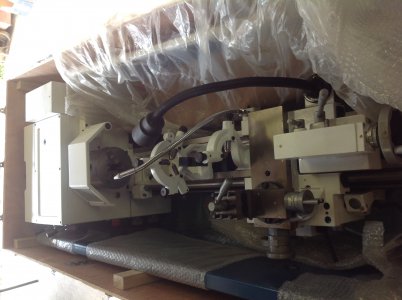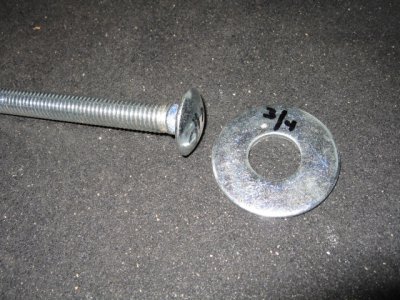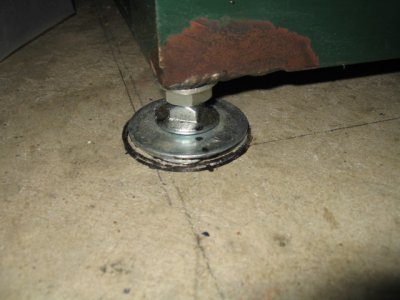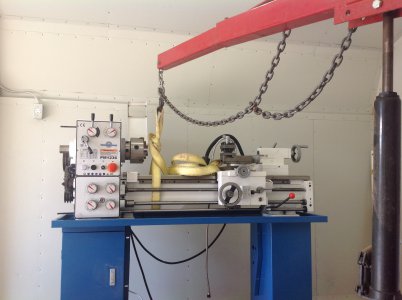 Hello all I'm new to this forum. I recently had the opportunity to purchase a pm1236. I look forward to learning all I can about machining on a lathe. I know some of the basics of using a lathe. The knowledge I've seen on this forum is second to none. I hope I am welcome here and I'm sure I will have lots of questions. And hopefully one day I can answer some. Here is a pic of the lathe when it arrived.
Hello all I'm new to this forum. I recently had the opportunity to purchase a pm1236. I look forward to learning all I can about machining on a lathe. I know some of the basics of using a lathe. The knowledge I've seen on this forum is second to none. I hope I am welcome here and I'm sure I will have lots of questions. And hopefully one day I can answer some. Here is a pic of the lathe when it arrived.-
Welcome back Guest! Did you know you can mentor other members here at H-M? If not, please check out our Relaunch of Hobby Machinist Mentoring Program!
You are using an out of date browser. It may not display this or other websites correctly.
You should upgrade or use an alternative browser.
You should upgrade or use an alternative browser.
Hello All. Newbi Here With A New Pm1236
- Thread starter G8R151
- Start date
Welcome aboard and congratulations on your new lathe. Let the questions begin! You have joined the most friendly and supportive machining related forum on the web.
And don't forget to post more pictures of your lathe assembly.
Tom S.
And don't forget to post more pictures of your lathe assembly.
Tom S.
Thanks guys. Here's another pic. I got the lathe set on its stand today. My first question is some info on some good levelers. The foundation is solid however it is not level. On a good 4 foot level the headstock is down hill about 3/16".
Wow, beautiful lathe, very similar to mine, welcome aboard and looking forward to reading more about your progress.
Re the foot adjusters, what mounting holes in the cabinets do you have to work with?
Mike
Re the foot adjusters, what mounting holes in the cabinets do you have to work with?
Mike
Last edited:
In case it might be of interest, there are 4 mounting holes on each of my lathe cabinets. I did not want to bolt to the floor for starters. That could be done later if problems cropped up.
The cement floor is smooth, sealed, 30 years old and very stable. There is a slope of almost an inch where the lathe sits.
The idea of shimming between lathe and cabinets did not appeal to me as a very friendly way to make adjustments. Also, caulking needs to be used to seal the holes in the top of the cabinet so oil does not leak into the cabinets. So my approach was to bolt the cabinets to the lathe with adequate caulking between cabinets, chip pan, and lathe and not have to revisit that joint again.
That meant that the feet on the cabinets needed to be adjustable. Rubber or other absorbing type mounts did not seem to offer as much stability as metal to cement might offer. However the feet couldn’t be slippery on the floor. Cost was a factor because it would be multiplied by 8!
The mounting holes location on the cabinets were too narrow for my liking. So before attaching the cabinets to the lathe I added some weld in each corner to reinforce the corner and tapped some 1/2’’ threads as close to the edge as possible. Some 1/2’’ carriage bolts were installed in each hole. A large flat washer was used under the head of the carriage bolt. The head of the carriage bolt can swivel in the flat washer to follow slope of floor. A soft aluminum shim was cut out a bit larger than the washer to put against the floor for grip and with the intent of using it as a feeler gauge. There are some details to add but that is it in a nutshell.
It was fairly simple to level the lathe with this set up and then keep an eye on how things settled. As it turned out, it only required a slight adjustment to one of the feet after two weeks of operation. For the last two years nothing has budged and the lathe has not walked from vibration to any extent. I am very happy with the way it turned out and how easy it is to keep tabs on the tension of each foot periodically.
The cement floor is smooth, sealed, 30 years old and very stable. There is a slope of almost an inch where the lathe sits.
The idea of shimming between lathe and cabinets did not appeal to me as a very friendly way to make adjustments. Also, caulking needs to be used to seal the holes in the top of the cabinet so oil does not leak into the cabinets. So my approach was to bolt the cabinets to the lathe with adequate caulking between cabinets, chip pan, and lathe and not have to revisit that joint again.
That meant that the feet on the cabinets needed to be adjustable. Rubber or other absorbing type mounts did not seem to offer as much stability as metal to cement might offer. However the feet couldn’t be slippery on the floor. Cost was a factor because it would be multiplied by 8!
The mounting holes location on the cabinets were too narrow for my liking. So before attaching the cabinets to the lathe I added some weld in each corner to reinforce the corner and tapped some 1/2’’ threads as close to the edge as possible. Some 1/2’’ carriage bolts were installed in each hole. A large flat washer was used under the head of the carriage bolt. The head of the carriage bolt can swivel in the flat washer to follow slope of floor. A soft aluminum shim was cut out a bit larger than the washer to put against the floor for grip and with the intent of using it as a feeler gauge. There are some details to add but that is it in a nutshell.
It was fairly simple to level the lathe with this set up and then keep an eye on how things settled. As it turned out, it only required a slight adjustment to one of the feet after two weeks of operation. For the last two years nothing has budged and the lathe has not walked from vibration to any extent. I am very happy with the way it turned out and how easy it is to keep tabs on the tension of each foot periodically.
Thanks for the info Toz. Your right each cabinet has 4 mounting holes in the bottom. I believe they are 3/4" holes. I thought about making something like you described but I was figuring it needed a pretty good size foot print to not be shaky up top. And I did put sealer between the cabinets and chip tray and also between the chip tray and the lathe
Don't understand your concern for shaking up top. Is it on a cement floor? The 3/4'' flat washers I used are 2'' in diameter. There are lock nuts to keep the bolt tight. Approx. 1400 lbs distributed on 8 points averages comfortably less than 200 lbs. per foot. Just saying.
I do think that a wider stance is a big plus because lathes are very top heavy.


I do think that a wider stance is a big plus because lathes are very top heavy.



